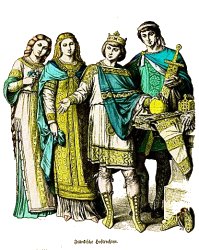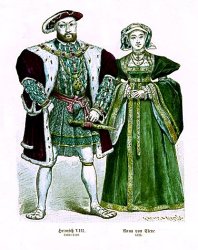|
|
|
|
|
|
|
|
"Everybody talks about the weather, but nobody does anything about it."
While this could describe the Carolingian approach to almost any issue, I
am in fact going to talk about the weather in this essay. (No, I'm still not
going to do anything about it.) Specifically, I'm going to talk
about how the weather changed.
How much can we know about something as undocumented, as ephemeral and everyday, as the weather hundreds of years ago? The traditional research approach has been archival: searching through chronicles, letters, or other written sources looking for mentions of the weather. This approach has its drawbacks: in the absence of standardized measurements, or a quantitative scientific approach, records are often in terms of "the worst/least/mildest flooding/rainfall/winter (or whatever) in living memory;" human memory being what it is, these sources can't be considered strictly accurate. More importantly, they're exceptional: they don't tell us what the usual weather was like, what that worst/least/mildest was being compared to. Still, this was for years the only place to start, and it does capture the human element. There is the physical/scientific approach, based on modern measurements of such physical evidence as the movements of Alpine glaciers, the growth-rings on trees (dendrochronology), or pollen counts in ancient peat bogs. While more accurate and more quantitative than archival research, these methods too have their drawbacks. They are sporadic and local, providing clues to the weather only for the time and place where the conditions were just right to create the physical record. Further, even with the help of carbon-14 dating it is no simple matter to locate these impersonal data on the map of human history. A third approach is the science of phenology, the study of archival data in the light of scientific knowledge; as such, it is a sort of combination of the two previous approaches. For example, dates of wine harvests were scrupulously recorded in France in the later Middle Ages, as were the dates of the cherry blossoms in Japan. A botanist can make fairly specific extrapolations of changes in average temperature and rainfall, as records indicate these events tended to come earlier or later in the year. By using all these methods in combination, scholars have begun to develop a picture of the changing climate of Europe over the period of the Middle Ages and Renaissance. Very briefly, from a warm and mild time at the height of the Roman Empire, the weather became colder and wetter between 350 and 400. This lasted almost 400 years, and began to improve around 750 (all dates are by necessity in very round numbers). The period from 800 to 1150 is called the "Little Climatic Optimum," and was marked by milder winters and drier summers north of the Alps, and summers that were sometimes too hot and dry in Mediterranean Europe. It got colder and wetter again in the 13th century (though in not as dramatic a change as the 4th century), then from 1350 to 1500 it got a bit warmer, though still wet and rainy. Then things went downhill in the 16th century, and the worst, coldest, and wettest weather of our period was from 1550 on. Indeed, the time from the cooling of 1150/1200 on into the 19th century is called the "Little Ice Age" by scholars in the field. These changes were not vast: average annual temperatures in good and bad periods varied by possibly no more than 1 degree Celsius, up or down. We're talking about a Little Ice Age, not woolly mammoths and clans of cave bears. (The Carolingian "Mastodon Blight" is another topic.) But it's likely they were enough to have an effect on human history. In the words of historian Robert Gottfried, "It must be re-emphasized that medieval Europe was an overwhelmingly rural society...and its economic well-being hinged directly on agrarian production." Crop growth and animal husbandry are directly dependent on the climate. That 1 degree C change was manifested in weeks of longer or shorter growing season and ice-free harbors, or in whether or not a district could grow a winter crop at all. A longer winter meant a farmer needed more firewood, and had a shorter summer in which to both gather that wood and still raise his crops; if his feudal obligations to the lord of the manor in crops or in labor remained the same as they had been in earlier, warmer centuries, then the quality of the peasant's life would have significantly changed for the worse. Certainly there do seem to be some correlations, some instances where changes in climate seem linked with big textbook-history trends. The deterioration of 350/400 coincides with the beginning of the collapse of the Roman Empire (the battle of Adrianople was in 378): agriculture would have been getting harder in general, quite apart from roving bands of barbarians. The improvement of 750/800 coincides with the start of Viking expansion (the raid on Lindisfarne was in 793): Scandinavia could support better than a bare subsistence economy. In fact, the Little Climatic Optimum matches the era of Norse expansion fairly closely. Taking advantage of a North Atlantic mostly clear of ice and easier to cross, the Norse settled in Iceland in the 9th century and Greenland in the 10th, and attempted to colonize the North American mainland. The Greenland settlement thrived in a climate mild enough to allow ample pasturage; by 1126, it was large enough to merit its own bishopric. But with the onset of the Little Ice Age, crossings became longer and more dangerous and the land less bountiful, and the settlement withered. By 1450, it had completely died out. (Vinland failed, but not for reasons of climate; Iceland survived, but just barely and very isolated.) |

|

|
| Frankish costume, 8th-9th c. | English/Flemish costume, 16th c. |
|
In the Current Middle Ages
I observe that the SCA experiences greater climate variation over space than the core region of medieval Europe experienced over time, and I wonder how much this has shaped our own culture. This is of course a long-standing subject of SCA pop anthropology: to what extent is Carolingia's concentration on dance and the other indoor arts based on our comparatively long, cold winters? (Think of our recurring problems getting an indoor site for fighting practice.) Is the West's fightin' and campin' society a more accurate recreation of period culture, or just a reflection of a milder climate? Talk with people who've played in other parts of the Known World; compare and contrast "Western Rite" and "Eastern Rite" SCA in this context. Use big shovels. Let me also take this occasion to vent a long-held gripe: over-heated, over-crowded feast halls at winter events. These are bad enough from the point of personal comfort, but they also impact on the quality of our re-creation. Late period garb is cold-climate garb, from the worst of the Little Ice Age; it's no mere coincidence that it goes in for so many layers, for so much fur and wool. But I just can't wear authentic Elizabethan winter garb to Twelfth Night; I'd be so uncomfortable I could never feel the "click," I'd never believe I was recreating the period experience. Last November's Crown Tourney was a chilly event for a lot of people, but chilly is authentic too. Further Reading The landmark text on the subject is Emmanuel Le Roy Ladurie's Times of Feast, Times of Famine: a history of climate since the year 1000 (1971). It's solid and thorough (some might even call it dense), and it covers our period more specifically than a lot of other books in the field do. Let me also put in a plug for a very small part of one of my favorite very big books, Fernand Braudel's two-volume The Mediterranean and the Mediterranean World in the Age of Philip II. In the original 1947 edition, Braudel tentatively advanced a suggestion that perhaps climate has changed over historical time, specifically that the weather was getting worse during the late 16th century. Then he added a couple of pages in the second edition, noting how much scholarly opinion had turned around in 15 years: climatic change is not only accepted now in general, but the 16th-century downturn is recognized as a strong example in particular. The contrast in tone between these two sections is delightful. I love this book; sometime I may do a whole column about it. I also recommend Jane Smiley's The Greenlanders, about the dwindling of the Norse settlements in Greenland in the 14th century. It's fiction, which makes it good at conveying what climatic changes mean at the level of individual people's lives. Fair warning: the story can be depressing, inasmuch as the reader can see the colony dying more clearly than the inhabitants do. The ships from Norway come fewer and farther between, but there's never a last ship; the farmers carry their cows out of the barns later and later in the spring (and some people say the cows once used to be strong enough to walk out on their own!), but spring does always come. The book is an intense read. |
|
|
|
text copyright 1999 by Caleb Hanson (e-mail) illustrations from the online version of The History of Costume, c. 1861-1880 by Braun & Schneider; also available from Amazon.com |
Home |
Usage |
Forums |
Articles |
Patterns |
Graphics |
Extras |
Contact Us


|